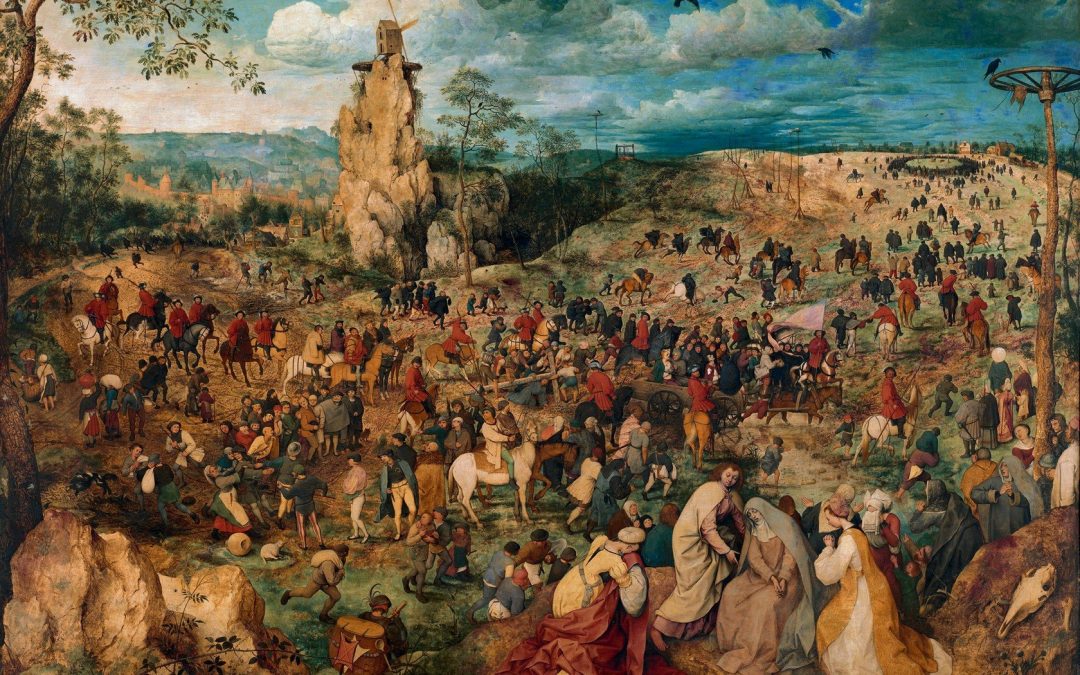
Covenant Theology II | Jesus, Plus Some Other Stuff?
In this second installment I will be addressing more of Henebury’s efforts to explain covenant theology to his readers. At this point, he still has not descended into the weeds because he’s just trying to steelman covenant theology by discerning its controlling principles. He’s setting up the rest of his series, and this is commendable. Where many might not take the time to do this, Henebury is genuinely attempting to understand and represent his interlocutors well. I hope I can return the favor in this article and the forthcoming installments.
What (or Who) is the Old Testament about? That is the central question of this piece. I am particularly focused on three paragraphs in this second article of Henebury’s. They read as follows:
What I want to point out is that there are two assertions here not one. The first assertion is that without the NT the OT “would remain largely veiled to us.” The second is that “we would see Christ only dimly.”
While there is no doubt that the second assertion is spot on, what about the first opinion? Notice that the whole OT is basically being boiled down to the figure of Christ. But although Christ is certainly crucial to the OT, isn’t it true that the Hebrew Bible is about more than Him? What about the covenants that God pledges to Israel and His election of them? What about Jerusalem and the temple? What about David’s throne in Jerusalem? Aren’t these perfectly clear as given by the OT? According to CT (and NCT’s) the answer is No! How come?
I think Brown & Keele answer this question well from a CT perspective. The thing to keep in mind, they tell us, is that there are in fact two distinct stages of fulfillment. The first level of fulfillment is what could be expected from the words God chose to use in the original contexts. But the second level of fulfillment is different.
What Is the Old Testament About?
Earlier, in his illustration designed to describe how outsiders perceive the hermeneutics of covenant theology, Henebury compares the interpretive priority of the New Testament required by covenant theology to a person who uses a secondary source (authored by a radical liberal critic) to understand a primary source (Dumas’ The Count of Monte Cristo). To bring our understanding of the New Testament into Old Testament interpretation is, for the dispensationalist, an “intrusion of an outside view upon the plain text of Scripture.”
In my lengthy quotation of Henebury above, he takes aim at the covenant theologian’s assumption that the Old Testament is reducible to the “figure of Christ,” at least as it regards understanding the significance thereof. But what if the New Testament itself invites us to make such an assumption? For example, in 2 Corinthians 3:14, Paul writes, “But their minds were blinded. For until this day the same veil remains unlifted in the reading of the Old Testament, because the veil is taken away in Christ.” Required to understand the Old Testament is repentance and faith in Christ, “when one turns to the Lord, the veil is taken away.” (v. 16)
In this instance, Henebury is responding to Brown & Keele’s book, Sacred Bond: Covenant Theology Explored. In that book, they essentially second what Paul says in 2 Corinthians 3:14. They write:
Of course, there are plenty of good reasons for our preoccupation with the New Testament. If the Bible were a building, the New Testament would be the penthouse suite; it reveals in glory and clarity Jesus Christ, our only Lord and Savior. The gospel in all its simple sweetness graces the pages of the Greek portion of Holy Scripture. Without it, the Old Testament would remain largely veiled to us, and we would see Christ only dimly. (101-102)
Henebury implies Brown & Keele deny that the Old Testament concerns covenants other than the gospel, the nation of Israel, David’s throne, etc. But even if they did elsewhere, that is not what Brown & Keele say in the section Henebury interacts with. Instead, they insinuate Christ as the interpretive key to a full understanding of the Old Testament. There is nothing substantially different in what they say and what the apostle Paul says in 1 Corinthians. One must understand the Old Testament in light of Christ, otherwise, it will remain veiled as Moses’ face was veiled, thus preventing the people from seeing the glory of God. (Ex. 34:35)
What About All the Other Stuff?
I doubt Henebury would deny the need for evangelical faith in order to rightly understand the Old Testament. The controversy resides in what to do with all the other stuff: Israel, the Davidic throne, the promised land of Canaan, future promises revealed in the Old Testament for Israel, etc. How do we account for these things? Henebury, presumably, would argue that we need to account for these things on the Old Testament’s own terms. But, given that these sweeping categories virtually subsume the whole of the Old Testament, they themselves could only be understood properly in light of Christ. If we try to understand them on the Old Testament’s own terms, neglecting the fuller revelation of God in the New Testament, we essentially try to read the Old Testament as the unconverted Jew does, practically rejecting the significance of the new covenant.
To be consistent with such a hermeneutical commitment would eventually land us in messianic Judaism or simply Judaism, being unable to read the Pentateuch in light of Hebrews 8:13 with its abrogation of the Mosaic covenant. To be clear, I’m not accusing Henebury of actually being a messianic Judaizer. But his method of understanding the Old Testament revelation strictly according to the Old Testament’s own terms would seemingly lead to a systemic rejection of any interpretive import from the New Testament.
Furthermore, what about Isaiah 53? How would one see the full sense of Isaiah 53 apart from the New Testament? To this day, Jews do not see Jesus in Isaiah 53. They see national Israel. Why is this? Could it be because the veil remains drooped over their hearts? They must turn to Christ, the Great Expositor of the Old Testament, to understand Isaiah 53 correctly. What about Isaiah 7? I’ll never forget my Old Testament survey class at a notoriously dispensational institution located in Southern California. We were not permitted to read Christ out of Isaiah 7. Isaiah 7, we were told, was all about Mahershalalhashbaz. This might as well have been our conclusion if it weren’t for the formula quotation in Matthew 1:22-23, “So all this was done that it might be fulfilled which was spoken by the Lord through the prophet, saying: ‘Behold, the virgin shall be with child, and bear a Son, and they shall call His name Immanuel,’ which is translated, ‘God with us.’” The New Testament teaches us how to understand the Old Testament.
In the final paragraph I quoted in the introduction of this article, Henebury describes “two distinct stages of fulfillment.” According to Henebury’s understanding of Brown & Keele, covenant theology holds that “the first level of fulfillment is what could be expected from the words God chose to use in the original contexts.” A more preferred term for this “first level,” in my estimation, might be the immediate sense. Some have called it the historical sense. But Henebury notes an additional level, but “[this] second level of fulfillment is different.” This “second level” we would rather call the fuller sense (sensus plenior). I believe this is what Brown & Keele are getting at, though the term “level” isn’t ideal.
The fuller sense isn’t wholly different from the historical sense anymore than a tree is wholly different from an acorn. The genetic coding for a full-grown tree resides inside the acorn, otherwise the acorn could never finally give way to the tree. The information inherent within the acorn anticipates and provides for later growth. Conversely, this later growth reveals the potential and purpose of the acorn in the first place, that is, to grow into a tree of this or that height, girth, etc. This analogy rings of Augustine’s well-known maxim, “The new [testament] is in the old [testament] concealed; the old is in the new revealed.” The tree is in the acorn concealed (DNA), the acorn is in the tree revealed (brought to its telos or goal).
Thus, it is not so much that there are two discontinuous and unrelated “levels” of meaning in the Old Testament, the second of which is only to be disjointedly introduced in the New. Rather, it is the case that the fullness of the Old Testament’s original meaning is brought to maturity in the pages of the New Testament or, more simply, in Christ Himself. For it is Christ who explains the whole of the Old Testament in light of Himself, “And beginning at Moses and all the Prophets, He expounded to them in all the Scriptures the things concerning Himself.” (Lk. 24:27) Note, the text does not tell us that Jesus interpreted some of the Scriptures in light of Himself, but it was “in all the Scriptures” (ἐν πάσαις ταῖς γραφαῖς) that our Lord had occasion to teach the things concerning Himself.
Introducing the Land “Problem”
This will be a theme to which we will return later on in the series. However, at this point Henebury introduces the issue of the land of Canaan and its eschatological significance and so I will speak to it briefly. He writes:
According to this “levels of fulfillment” view the covenant promises of God about seed and land were fulfilled in OT times. Brown and Keele, following many CT’s, say that the land promise was fulfilled at the time of Joshua (see Joshua 21:21:43-45, Ibid, 92). Having placed the land promise in the past the next stage of fulfillment can be given all the attention. In CT God ‘s fulfillment of the land promise to Israel, having occurred already, can be made into a foreshadowing of something else; something greater. And this “something greater” is realized at the first advent as a result of “Christ’s person and work.”
According to Henebury, Brown & Keele note the unequivocal fulfillment text in Joshua 21:43, “So the LORD gave to Israel all the land of which He had sworn to give to their fathers, and they took possession of it and dwelt in it.” This is a significant problem for those who make the claim that the land promise was never fulfilled in the Old Testament. It obviously was. But nothing in dispensationalism requires such a hard claim. Some dispensationalists may as well make room for two or more fulfillments of the same promise, and even view a measure of escalation in each fulfillment.
However, given my above thesis, that the New Testament itself requires we read the Old Testament in light of it, the land of Canaan, like the acorn, was certainly destined for a higher purpose. Its purpose was to grow into something greater. I believe this can be seen in the Old Testament, such as in Isaiah 57:13, where the land is given by faith, which was not how the land was originally given to the descendants of Abraham. Those descendants were required to be circumcised and keep the Mosaic law inherently implied by circumcision following the Sinaitic covenant. (Gal. 5:3) Nevertheless, it is the New Testament that unfolds the original purpose and significance of both the law and the land, “But now they desire a better, that is, a heavenly country. Therefore God is not ashamed to be called their God, for He has prepared a city for them.” (Heb. 11:16)
Texts like Hebrews 11:16 teach us that the land of Canaan was only a foretaste of that which was to come and that which was ultimately desired by the Old Testament saints. The heavenly country in Hebrews 11:16 isn’t the land of Canaan, per se, and it isn’t distinctively Jewish as many dispensationalists would have it. Hebrews 12:18-24 later defines this heavenly Jerusalem as something possessed by the saints. It comes with the receiving of the kingdom (v. 28), and it is unshakable. Its immovable nature suggests transcendence of the millennial period which most dispensationalists envisage to represent a temporary state of affairs taking place just prior to the new heavens and new earth. Such a heavenly Jerusalem should be connected to the new Jerusalem in Revelation 21, “coming down out of heaven from God, prepared as a bride adorned for her husband.” (v. 2) More on this throughout.
Conclusion
None of the above, of course, registers as valid hermeneutical discourse if the New Testament is set aside during the process of interpretation. If the Old Testament can only be read in terms of the Old Testament, then we are forced to do what the New Testament authors themselves did not do, namely, refuse to read the Old Testament in light of the incarnation, sufferings, and glory of our Lord.
I like the illustration Henebury uses to describe how the covenant theologian thinks of his own position, “People had been watching everything in black and white and they were used to it. When color TV’s were brought home they brought so much life to the screen. It was a new world. People were seeing the actors and their backgrounds and their cars in a brand new and vibrant ways. You could see better! That is similar to the way CT’s understand the way the NT changes the way we look at what had come before it.” The Old meaning doesn’t become irrelevant with the New. Rather, it comes into focus. It comes into its own. And it does so only in the Lord Jesus Christ.
Resources





